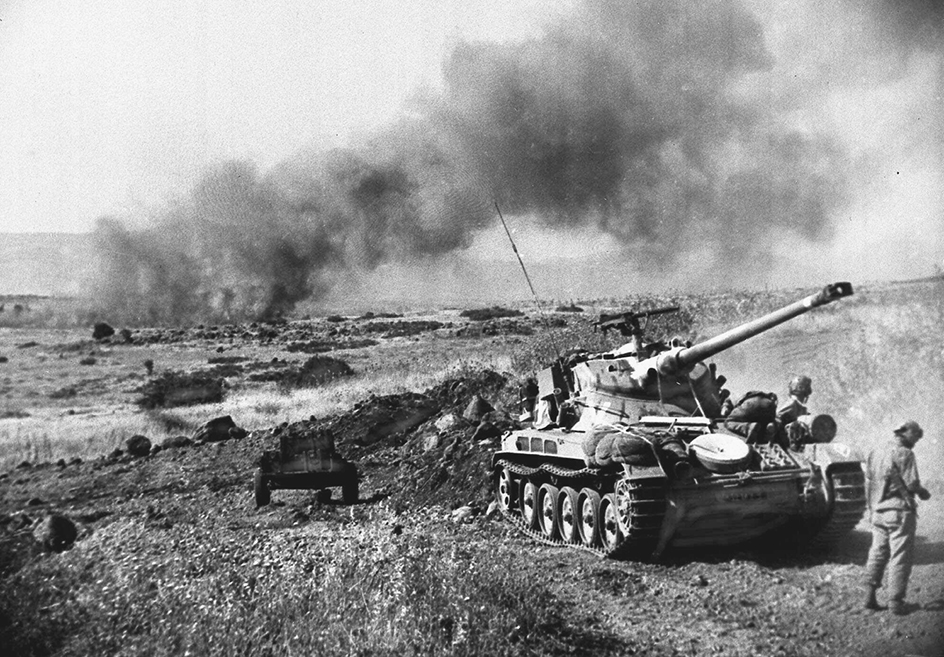Six-Day War was a 1967 clash between Israel and the Arab countries of Egypt, Jordan, and Syria. The fighting took place from June 5 to June 10 and ended in a decisive Israeli victory. However, the outcome led to further conflict and tensions in the Middle East. The Six-Day War is also known as the June War or the Arab-Israeli War of 1967. Iraq, Lebanon, Saudi Arabia, and other Arab nations played small roles in the conflict. 
Background.
The Six-Day War was the third major Arab-Israeli conflict. The first began after the nation of Israel was established on May 14, 1948. Neighboring Arab countries refused to accept Israel’s existence, and they attacked the new nation. Israeli troops fought the armies of Egypt, Syria, Lebanon, Transjordan (now Jordan), and Iraq. An armistice ended the war in February 1949 and left Egypt in control of the Gaza Strip on Israel’s southwest border. Jordan gained control of the West Bank. Israel controlled the western half of Jerusalem, and Jordan held the eastern half. More than 700,000 Palestinian Arabs fled or were driven out of Israel. After the war, many Arab countries refused to accept Israel’s existence.
Major fighting erupted a second time after Egypt seized the Suez Canal from the British and French in July 1956. That October, Israeli forces attacked Egyptian troops in the Sinai Peninsula between Israel and the canal. Israel, with British and French help, quickly took control of the canal and occupied the peninsula. In early 1957, the United Nations (UN) forced Israel to return the Suez Canal and the Sinai Peninsula to Egyptian control. To keep the peace, the international United Nations Emergency Force (UNEF) took positions around the canal, in Gaza, and in the Sinai.
Arab-Israeli tensions increased in the 1960’s. In April 1967, a skirmish in Syria’s Golan Heights led to an air battle between Israeli and Syrian warplanes. Egypt, pledging military support for Syria, demanded that UNEF troops leave the Sinai. Egyptian troops and tanks flooded into the peninsula. Egypt also blocked the Straits of Tiran in the Gulf of Aqaba. The blockage cut off the important Israeli port of Elat from the Red Sea, which Israel considered an act of war.
Syrian troops massed above the Israeli border in the Golan Heights. On May 30, Jordan joined the Egyptian-Syrian alliance. Arab leaders—most notably Egyptian President Gamal Nasser—called for Israel’s destruction. Some 330,000 Arab troops surrounded Israel, along with about 2,000 tanks and 600 warplanes. Israel’s forces included about 250,000 troops, 1,000 tanks, and 250 warplanes. They were outnumbered, but they were better equipped, trained, and coordinated. After failed diplomatic efforts, Israel struck before the Arab forces could attack.
The war.
Early on June 5, 1967, Israeli warplanes struck several Egyptian air bases. The attack destroyed hundreds of Egyptian planes. At the same time, Israeli tanks and infantry smashed into Gaza and the Sinai, routing Egyptian ground forces. By June 7, Israel had taken the Sinai.

Late in the morning on June 5, Jordanian artillery and warplanes struck positions in northern Israel, including Tel Aviv and west Jerusalem. Israel responded with air strikes that wiped out the Jordanian air force. That afternoon, Israeli troops began battling Jordanian forces in and around Jerusalem. Israeli warplanes destroyed Jordan’s reinforcement convoys. By the morning of June 7, only pockets of Jordanian troops remained in Jerusalem. Israeli forces then entered and gained control of Jerusalem’s walled Old City. By nightfall on June 7, Israel had taken the West Bank.
Syrian artillery and warplanes attacked Israeli targets along the Syrian border on June 5. Later that day, Israeli warplanes destroyed most of the Syrian air force. After fighting in the Sinai and the West Bank ended, Israel turned its attention to Syria’s heavily defended Golan Heights. Early on June 9, Israeli warplanes battered Syrian troops entrenched on the heights. By noon, Israeli ground forces had entered Syria. Fierce battles erupted all along the border, but Israeli troops soon controlled the Golan Heights. A cease-fire on June 10 ended the Six-Day War.
Aftermath.
About 800 Israelis died in the Six-Day War, and another 2,400 were wounded. Combined Arab casualties (people killed, wounded, missing, or captured) were about 50,000, including more than 14,000 dead.
In November 1967, the UN called for Israel to withdraw from territories it gained in the war. In return, the Arab countries were to recognize and accept the nation of Israel’s right to exist. Israel, however, refused to give up the captured territories, and the Arab countries renewed their opposition to Israel.
Egypt and Syria again attacked Israel in the 1973 Yom Kippur War. This larger conflict ended in a stalemate. The Sinai Peninsula was returned to Egypt in 1979. Israel withdrew from the Gaza Strip in 2005 but maintains control of its borders. Israel still occupies the Golan Heights and parts of the West Bank.
See also Dayan, Moshe; Eshkol, Levi; Hussein I; Suez crisis.
